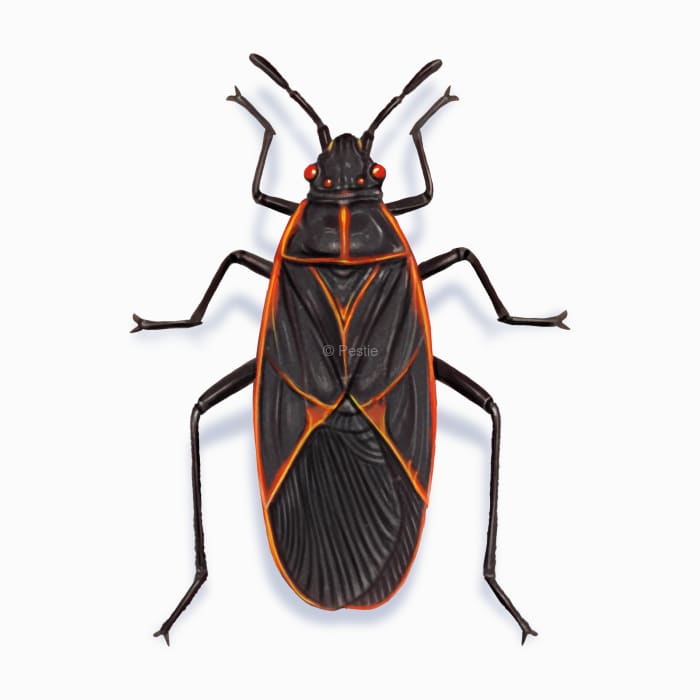How to identify and get rid of boxelder bugs

Preventing the fall invasion: keeping boxelder bugs out of your home
Fall brings a change for most people as the weather gets colder and everyone starts to move indoors more. Boxelder bugs are no different. These black and red bugs ditch the chilly temperatures and head for warmer spaces… like your home!
While boxelder bugs prefer maples, ash, and boxelder trees, they often find their way through gaps, cracks, and openings to overwinter inside, causing you to wonder where this nuisance is coming from.
How to identify boxelder bugs
Boxelder bugs are a part of the ‘true bug’ family, closely related to stink bugs, lace bugs, and cicadas. They have a beak or piercing mouthpart they use to suck out the juices from plants and seeds.
The adults are black with red lines that border the body. The wings overlap making an ‘X’ shape and the wings are all black on the tips near the abdomen.
Boxelder bugs also have red eyes and their antennae have 4 segments. Additionally, their immature nymphs are all red and as they grow, they develop more of the black coloring on their wings.
How big are boxelder bugs?
The adults are only ½ inch long.
What other insects look like a boxelder bug?
Boxelder bugs are often confused with milkweed bugs or western conifer seed bugs which have similar markings but are more orange or elm seed bugs.
Additionally, some people think boxelder bugs are the dangerous kissing bugs that transmit Chagas disease. However, they have a conehead and red or orange stripes along the border of their body.
Where do boxelder bugs live?
There are two species of boxelder bugs, the eastern boxelder box and the western boxelder bug. They inhabit both the Eastern and Western parts of North America respectively.
During the summer, they usually hang out on ash, maple, or boxelder trees, but can sometimes make their way into gardens.
They like to congregate in sunny spots to warm themselves.
How to get rid of boxelder bugs
Since boxelder bugs are coming inside to stay warm during the winter, the best step to keep out boxelder bugs is preventing them from getting inside.
Help prevent boxelder bugs by:
- Sealing up entry points
- Repairing or replacing damaged screens on windows or doors
- Installing door sweeps
- Applying a bug barrier around your home
Once boxelder bugs enter your home, you’ll want to physically remove them with a vacuum, broom, or dustpan. They won’t reproduce or harm you or your home once inside. They are mostly a nuisance when they congregate in large numbers.
If you crush them, you risk staining the surface they were on and releasing a foul-smelling scent.
You can establish a bug barrier around your property to help keep boxelder bugs out. Check out Pestie’s DIY, pro-grade solution for year-round protection from pests.
Treat boxelder bugs with Pestie
If you're still having trouble keeping boxelder bugs away, the best option is to use a pro-grade, effective pest control solution like Pestie.
Pestie is a do-it-yourself pest control solution that's specially designed to keep boxelder bugs and other pests away from your home.
With Pestie, you can rest easy knowing that your living space is protected and free of creepy crawlies. And the best part? It's designed for people, pets, and the planet, so you can say goodbye to harsh chemicals and hello to peace of mind!
- Save hundreds compared to traditional annual pest plans
- People, pet, and planet-friendly
- Pro-grade customized formulas
Quick facts
- Scientific name
Boisea trivittata
- Other common names
Box Bugs, Maple Bugs, Box Beetles
- Colors
Black with red and orange markings
- Life span
1 year
- Diet
Plant juice and seeds
How dangerous are Boxelder Bugs?
Low danger risk
Boxelder bugs are more of a nuisance than a health concern. They don’t carry or transmit any diseases and they will only bite if you try to pick them up. Additionally, they don’t do any damage to your home, food, or pets. They can be an issue with damaging maple, ash, and boxelder trees, but this is rarely the case.
Boxelder bugs congregate together in clumps and can release a smell to deter predators from eating them. This is why very few animals will eat a boxelder bug.








